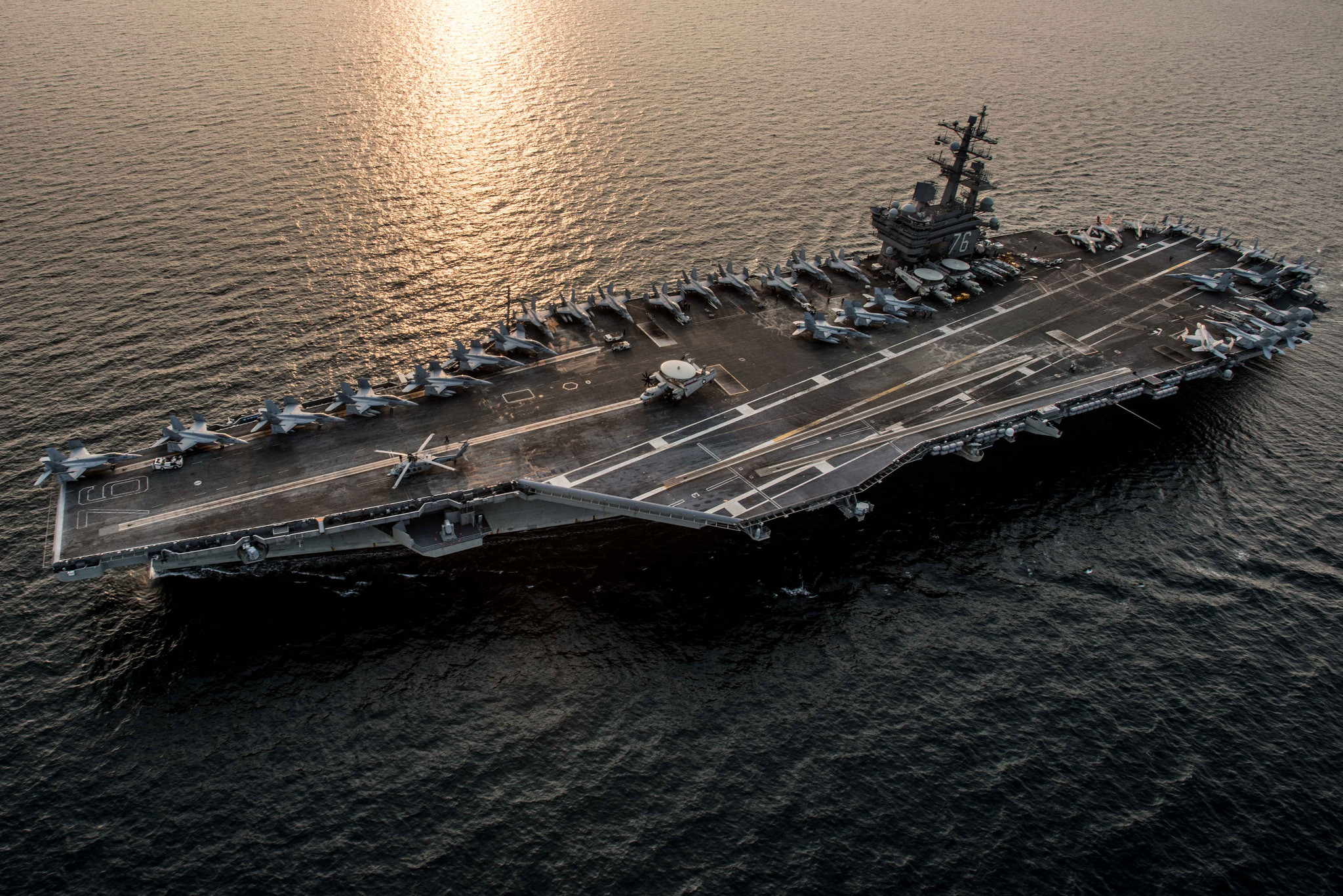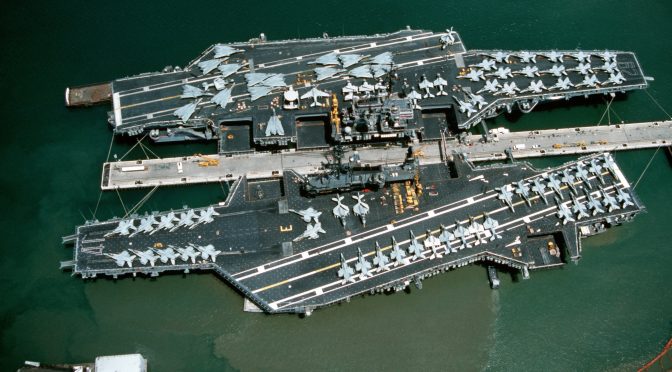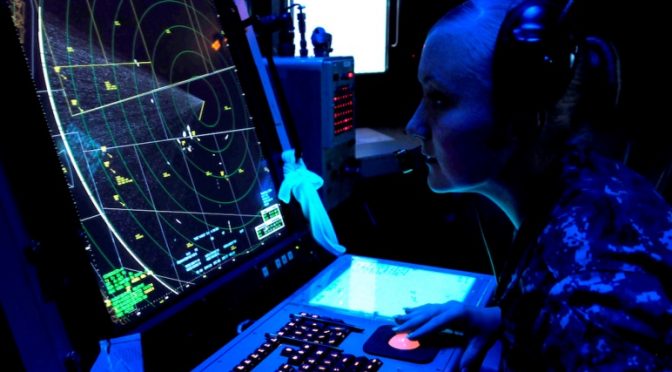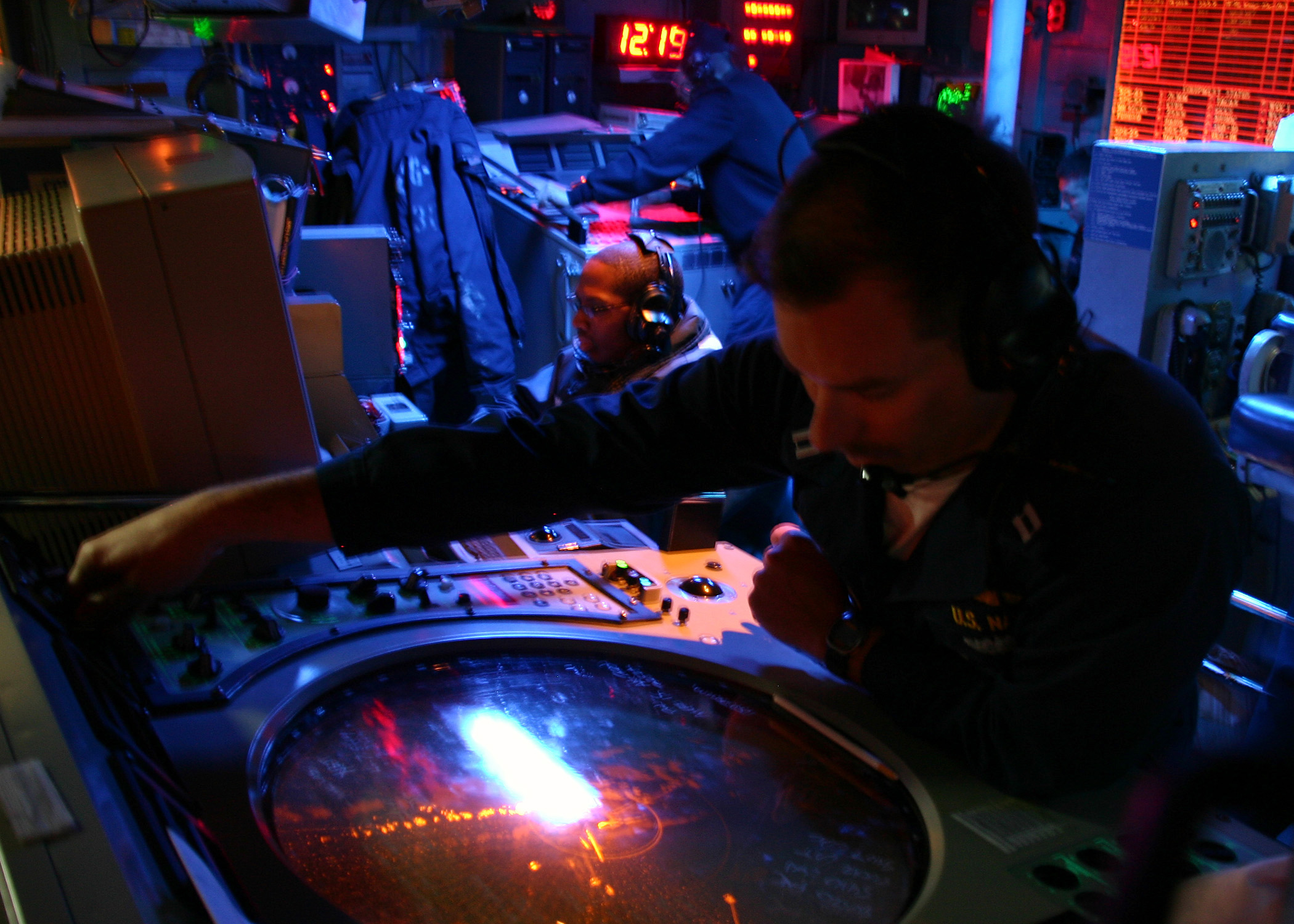By LT X
The age of the strike carrier is over. As the United States enters an era where the potential for modern great-power war is increasing dramatically in Eurasia, a return to the traditional roles of the aircraft carrier is required to maintain maritime access. Carrier-borne over-land strike warfare has not proved decisive in previous conflicts in heavily contested air defense environments, and will not prove so in the future. In the potential high-end conflicts of the twenty-first century, the likely utility of carrier-based land strike is largely non-existent. Thankfully, the traditional carrier aviation roles of maritime interdiction and fleet air defense remain highly valuable in wars against modern navies, but are precisely the roles, missions, and tactics sacrificed for sea based over-land strikes over the past sixty years. Regaining this capability will require a modest investment in existing and developing systems and capabilities and should be the force’s, the service’s and the nation’s highest objective in the coming years.
Aircraft Carriers in Over-Land Strike
American carrier airpower received its combat indoctrination in the Pacific War. However, pollution of the history of that campaign by naval aviation and airpower enthusiasts caused the lessons of that war to ossify over time. During Fleet Admiral Chester W. Nimitz’s campaign aircraft carriers and their air wings almost exclusively provided maritime interdiction and fleet air defense. There are three major exceptions to this rule; Doolittle’s raid, the offloading of the Enterprise air group to Henderson Field during the Solomon Islands operation, and the strikes against the Japanese redoubts and the home islands late in the war. Additionally, carrier air forces provided strikes to Marine landings and naval aviation supported the Army landings of MacArthur’s campaign, most famously at Leyte. Admiral Kinkaid’s light carriers supported much of this effort, as well as Vice Admiral William F. Halsey’s and Raymond Spruance’s fast carrier task forces of Third and Fifth Fleets.
Doolittle’s raid, a strategic success due to its propaganda value, did not obtain any operational or theater-strategic gain, provided no notable hindrance to the Japanese war effort, and was conducted with US Army Air Corps (USAAC) B-25 Mitchell aircraft. Only the USAAC aircraft possessed the combination of ordnance load, endurance, and thrust to make the adventure over the Japanese home islands possible, even as a publicity stunt.
When the Enterprise disembarked her air group to Henderson Field, her aircraft provided valued support to the Marines fighting their way across Guadalcanal and to American naval forces fighting for sea control in Iron Bottom Sound. During the campaign, the major value of those aircraft remained air defense and anti-surface warfare. The Enterprise air group made combat air patrols, searched Iron Bottom Sound during daylight, and engaged any Japanese ships unfortunate enough to find themselves in range in daylight. The Enterprise air group’s combat air patrols made daylight resupply of Japanese Army units impossible, a sea control, anti-surface warfare capability. While the air group could not provide enough firepower accurately enough to dig the Japanese out of the jungle by themselves, it successfully isolated the battlespace to allow the Marines to do their work as it controlled the approaches to Iron Bottom Sound.
After Midway and the Solomon Islands campaigns, American carrier air power did begin to conduct some overland strike, mostly in the form of raids on enemy bases, but the fast carrier task forces remained focused on fleet air defense and anti-surface warfare. This alludes to the fact that, despite its ailing naval forces, Japan’s air and surface units still represented a potential threat to the American war after 1942. This was true as long as they possessed the capability to conduct a highly destructive strike against American fleets.
Leyte Gulf totally destroyed this capability and thereafter American carriers began wholehearted support of major fleet landings. However, in these endeavors they posted a mixed record, being unable to provide enough ordnance precisely enough to make the Marines’ tasks much easier as they tried to advance over hard volcanic rock on Iwo Jima and the difficult terrain and defense in depth on Okinawa. Indeed, in these campaigns, American carrier air power’s signature achievement proved the destruction of the Japanese super-battleship, not any air-to-ground ordnance delivery.
The history of the Second World War has been polluted by naval aviation, claiming the conflict as the age of the aircraft carrier. This stands almost no historical scrutiny. The campaign hung in the balance in the Solomons as much as Midway or Coral Sea, with no U.S. carriers available. Moreover, battleships proved highly useful throughout the war with their extensive anti-air armament and state-of-the-art radars providing close-in air defense for task forces. The Pacific War’s history is much more nuanced than naval aviation enthusiasts give credit for, and at its conclusion, not the carrier but the aircraft carrier task force proved to be the central weapon of war, with naval aviation posting meager results in ground support or strategic land strike.
What commonly became known as the “strike” aircraft carrier (CVA) was, in fact, the atomic carrier. In a memorandum as assistant Chief of Naval Operations for guided missiles, Rear Admiral Daniel V. Gallery opined that the U.S. Navy could strike more flexibly, as effectively, and at less cost than land-based, atomic-armed bombers requiring local bases to launch their fighter escorts. Gallery’s motivation was at least partially parochial. The newly-formed U.S. Air Force was, at the time, attempting to cultivate a monopoly on nuclear strike planning. In the era as the only nuclear superpower, it seemed nuclear delivery would prove the best option for continued longevity of the U.S. Navy’s fleet. In this effort, the Navy reconfigured attack carrier air wings to deliver Navy special weapons. This reconfiguration was the first time a carrier air wing was doctrinally tooled for ground attack and strategic strike, vice the sea control disciplines of fleet air defense and anti-surface warfare. Over time, this strike carrier became the norm. Rather than provide value to the fleet, misperceptions of the efficacy of land attack caused the platform’s gradual devolution from a system that provided capability to the task force to a platform that sucked capability from it. With its air wing largely servicing land targets, the strike carrier now required the very anti-surface, anti-submarine, and anti-air capabilities it used to augment, to allow more substantial (although increasingly less effective) overland raids.
This strike configuration premiered during the Korean War. The Peninsula lacked a sophisticated air defense or early-warning system and communist forces only contested air superiority in MiG Alley on the western Sino-Korean border. Therefore, naval and Marine aircraft operating off of carriers did produce notable results in ground support. However, given the limited nature of the conflict, the austere environment of the peninsula, and the technical lack of sophistication of Chinese and Korean forces, it is hard to determine the overall effect of carrier air power. At any rate, whatever the tactical, operational, or strategic limitations imposed, the conflict ended inconclusively, whatever naval aviation’s record.
https://gfycat.com/ThankfulChubbyBullfrog
Aircraft launch off USS Valley Forge during the Korean War (Naval History and Heritage Command)
Likewise, the utility of the attack aircraft carrier proved mixed over Vietnam. During the Vietnam War, the communist North enjoyed competing Chinese and Russian military (as well as diplomatic and political) support. The Soviets provided a totally linked and integrated air defense network around vital areas including Hanoi and Haiphong Harbor, the two most strategic areas. This air defense system proved too dense and advanced for American carrier-launched aircraft to reliably penetrate and deliver ordnance. Indeed, during Operation LINEBACKER II, only B-52Ds with their improved Electronic Countermeasure (ECM) packages, proved able to operate in the zones. This represented a failure of American carrier air power. If the multiple aircraft carriers operating in the Gulf of Tonkin could not reliably penetrate North Vietnamese air defenses, what chance did they have off the Kola Peninsula or the Baltic?
Despite an air defense network similar to that installed over Hanoi, U.S. Naval Aviation contributed, but did not prove decisive in Desert Shield and Desert Storm. While fixed-wing, fast moving aviation assets provided impressive combat support, it took US Air Force F-117 Nighthawks, cruise missiles, and Air Force delivered precision munitions to penetrate the Iraqi air defense screen. Naval air forces proved totally unprepared for the precision munitions revolution, lacking laser target designators on the A-6s and A-7s that still formed the mainstays of the fleet. Instead, most naval aviation delivered Mk 80 series unguided weapons instead of the Paveway series carried by a small but growing section of Air Force platforms, including the Nighthawk. This made them incapable of delivering ordnance to targets with high risk of collateral damage and precluded many targets in Iraqi population areas, limiting the force’s contributions to the campaign to tactical and some operational strikes.
In the Balkan wars and later in Iraq and Afghanistan, American naval aviation never again faced an integrated air defense system. High hard decks precluded the efficacy of man portable surface-to-air rounds and obsolete mobile systems made air defense suppression a forgone conclusion rather than an aspirational goal in the early 2000s. Naval aircraft, belatedly modernized to take full advantage of the precision munitions revolution, delivered substantial amounts of ordnance in these conflicts, complementing American land-based air power. However, the aircraft lacked on station time and payload, showcasing a service preference for multi-role fighter-bombers with limited range vice the ultra-long range fighter and attack aircraft required for intercept and long-range anti-surface warfare. However, confronted with a total lack of modern air defense systems, they, like the Air Force, reigned supreme.
Never in its history has American naval aviation confronted a state-of-the-art, integrated air defense system and provided effective, strategic ordnance. Hypothetically, at times during the Cold War, American strike-configured carriers might have done so, but an era of fiber-optically interlinked, multi-frequency, phased array air defense systems totally precludes such operations. Moreover, naval aviation assets lacked the range to strike strategic targets deep in mainland China and central Russia, limited to around 1,000nm inland.
Modern Aircraft Carrier Utilization in Great Power War
The utility of the STRIKE carrier in great power conflict is over. More accurately, as the previous section highlighted, it never really existed. American strike carriers throughout their history proved incapable of gaining and maintaining access to heavily defended areas and this trend will only grow more severe. China’s Great Wall of air defense on the northern Taiwan Strait will again preclude American carriers from gaining access to strategic areas in mainland China. Russia’s high-value areas are already well defended. China’s continued investment in air defense systems will cause this problem to continue to distribute throughout Asia. Further, a series of anti-access systems fielded by China, but also increasingly by Russia, are pushing U.S. carrier task forces out of range of present naval aircraft.
American planners are hoping, almost as a matter of faith, that an increase in the range of carrier-based aircraft would provide for continued access. This approach is wrong-headed. First, what land targets would such aircraft service? Perhaps Hainan Dao, or some rocks in the South or East China Sea, hardly a war-winning strategic strike. Second, how will these aircraft gain access in order to deliver the strike? American naval aircraft are too obsolete to deal with any but the most lightly defended of modern targets, and the F-35 will not markedly change this equation.
So let’s give up? Call it a day? Beef up Air Force appropriations? Not even close. American naval air power is the critical capability in the U.S. arsenal in the Western Pacific and the North Atlantic. Instead, force planners should recall why the U.S. built aircraft carriers in the first place, and where they last played a critical strategic role: in anti-surface warfare and fleet air defense. American carrier air power in the Pacific War hinged not on great strikes against the home islands, but rather on massing striking power against Japanese naval surface forces, Japanese air forces, and by protecting the fleet during operations and major landings. This is where naval aviation must again put its efforts.
Air wings at present are much better configured for low-risk ground attack than for operations against other navies. Air operations in the Pacific War required mass, exercising Halsey’s axiom that carrier air power increased at the exponent of the number of carriers engaged. Those operations encompassed large sorties, with hundreds of aircraft in major fleet actions. Over the past twenty-five years these skills have been lost. American carrier forces now exercise in single or dual carrier configurations. In Halsey and Spruance’s era, their fleets swelled into double digit large flattops, with myriad small deck escort carriers providing combat air patrols, anti-submarine forces, and landing support. Additionally, that war featured raids of hundreds of naval aircraft against enemy surface formations. Critics will claim that such mass is no longer required in the precision munitions era but such claims ignore that defense systems have also improved dramatically, making saturation the only sure way to put sophisticated, modern air defense ships out of action. To be clear, this author is not advocating a wholesale return to Nimitz’s fast carrier task force. However, the tactics, techniques, procedures, and training of American carrier air forces are out of touch with a modern, sea-control war, and a single U.S. CVN must be able to generate the mass and firepower necessary to fight in a modern, contested sea environment.
American naval aviation forces have not experienced platforms with the anti-air capabilities of ships as capable as the current generation of Chinese Navy Luyang hulls. U.S. tactics presently involving two or four aircraft sorties are totally inadequate for destroying an AEGIS-equivalent ship. To overwhelm a Chinese, or even an aging Russian surface formation, will likely require dozens of anti-ship cruise missiles. A single carrier must contain the capability to put such a ship (ideally many such ships) out of action, quickly. However, at present such a task requires the bulk of a modern air wing to generate the volume of fire required. This would likely also require a total re-arming of carrier magazines with a focus on sea control weapons and systems lest a CVN run itself out of anti-ship missiles in a few early engagements.
Moreover, distributed lethality requires a distribution of air power. Without fast-moving defensive counter-air formations operating with small surface action groups, American light forces will find themselves extremely vulnerable to attack. Modern surface combatant anti-air weapons range remains about 100nm. Modern air-launched anti-ship cruise missiles regularly feature twice that range and increasingly much greater. Without defensive counter-air formations attached to light surface forces, enemy aircraft will use the haven of range to mass firepower, overwhelming a formation’s air defenses while maintaining relative safety over the horizon. Allowing distributed light forces some measure of defensive counter-air capability will allow those formations to break up air attacks, ideally precluding saturation of U.S. platforms, offset electronic emissions away from the formation to make enemy targeting of the group more difficult, and therefore dramatically increase survivability.

The United States certainly has the capability to maintain the primacy of its carriers, especially in the maritime-dominated Western Pacific. The U.S. must use its large-decks to maximum potential. This includes American large-deck amphibious shipping, in the form of LHDs and LHAs. Such ships’ amphibious capability will likely not add much to the initial phases of great power war when sea control and air superiority are contested. Importantly, small carriers proved highly useful in both Atlantic and Pacific theaters of the Second World War, providing long-range air defenses for convoys and robust anti-submarine capability outside of the range of land-based air power. In the 1960s, the U.S. began using Essex-class carries in an anti-submarine configuration (CVS vice the strike carrier CVA). In fact, USS Intrepid, a CVS-configured carrier, conducted strikes into northern Vietnam off Yankee Station, when it became apparent that PRC submarines did not pose a serious threat to the American Carrier Operating Areas (CVOAs). Likewise, the British prioritized antisubmarine work and limited air defense capability in their Invincible-class light carriers which featured heavily in the Falkland Islands War. American Wasp– and America-class ships, loaded with F-35s, SH-60s, and MV-22s, can provide the same – an air defense, anti-surface, and anti-submarine screen. Operating in the vicinity of a Surface Action Group Operating Area (SAGOA), the large-decks could provide on-station defensive counter-air, visually identify unknown contacts, and augment the ASW aircraft from a SAG to increase the group’s submarine localization and anti-surface strike capacity.
American naval forces are only a fraction of the way to recognizing the capabilities the MV-22 provides. At present, the U.S. Navy has only tested MV-22 Osprey tiltrotor aircraft in a Carrier Onboard Delivery (COD) capacity, the CMV-22. However, the aircraft retains substantial potential in anti-submarine warfare and airborne early warning, among other uses. U.S. Navy carrier task forces until the early 2000s incorporated the S-3 Viking aircraft, a high-subsonic anti-submarine jet. These aircraft retired in the early 2000s due to lack of fleet interest in anti-submarine warfare. In the heavily contested North Atlantic or Western Pacific, against foes with modern undersea forces, such a capability once again is required. The MV-22 would expand this capability. While slower, it provides potential marked improvements in range, low-altitude handling, on station time, and sensor payload. Such aircraft would provide a step-increase in surface-force ASW capability, potentially loaded with dipping sonars, sonobouys, and a large number of Mk 54 torpedoes. Further, mounting a high-performance radar on such an aircraft would allow some measure of airborne early warning to small surface units. Combined with point-to-point data links, these aircraft could provide over-the-horizon situational awareness while limiting surface force’s radar transmissions. This would complete the capability of the light-carrier air group described above and substantially increase the lethality of the small satellite surface groups orbiting the aviation ship. Additionally, due to their vertical takeoff and landing capability, the MV-22 could potentially lily pad off smaller ships, particularly the huge flight decks of Independence-class Littoral Combat Ships (LCS) increasing their time aloft forward. While heat management proved frustrating early in the aircraft’s tenure, this issue has been fixed with temporary heat shields which could be staged onboard. The MV-22 provides a cheap method to reconstitute integrated ASW capability and provide survivable, high-speed warning and reconnaissance.
U.S. Naval Aviation must train for saturation raids, publicly. Saturation attacks are a lost art, and likely aviation forces have much to learn. Such attacks will require heavy coordination between aircraft and squadrons, flexing intellectual muscles left dormant since at least the end of the Cold War. Is a saturation attack down one bearing better, with inbound missiles exceeding the target’s sensor capacity in a single direction, or better from multiple vectors or compass points, overloading close-in defenses? Such questions require at-sea testing. Additionally, such training is an important signal to U.S. maritime adversaries. The fact that U.S. naval aircraft are prepared to destroy high-end platforms, and have the capabilities to do so, emphasizes U.S. resolve in an era and in areas where such capability is in question.

Ultimately, the F-35 has a huge role to play in a reconfigured carrier air wing. Without it, the U.S. Navy will have no answer to the range of proliferating fifth generation fighters it would face in the Barents, Baltic, or China Seas. Joint Strike Fighter’s use is not bombing the Senkakus or trying to break into mainland China’s air defense network. Instead, only the F-35, to include or perhaps even feature the F-35B flown off LHDs and LHAs, can provide the protection of U.S. light forces and the carrier itself with an aircraft capable enough to survive in a modern air war. Forward distribution of the F-35 in support of U.S. light forces will provide a critical capability to those ships operating at the far reaches of U.S. sea control when they confront the J-20 and Su-35, armed with large numbers of long-range anti-ship missiles.
Finally, naval air must expand the capabilities of the legacy and Super Hornet variants of the FA-18 with software upgrades and improved radars and sensors, to help electronics warfare and battlespace awareness functions on the aging airframes to keep pace with F-35. The F-35’s stealth will not be decisive in future conflicts. The frequency agility of modern air defense sensors is just too good. Only the survivability and lethality of the weapons it carries will keep these airframes lethal into the future. Hornets must maintain their capability in the areas of fleet air defense and anti-surface warfare by a refresh of the aircraft’s sensors and systems. This is not to preclude F-35. Without the Joint Strike Fighter, the only fifth generation fighter available, American carrier air forces will be obsolescent by the end of the decade. However, the Hornets will also have to operate in the same environments, and need to be configured to do so.
Conclusion
American naval forces are not a tool for strategic strikes. Instead, they should be used operationally, to provide strategic affects. A great power war will require progressive sea control, as attrition dominates seagoing forces on both sides. At some point, one side or the other will alone maintain the capability to operate in the contested theater. Naval aviation should use its striking capability to advance this attrition-based operational concept as quickly as possible by massing its striking power quickly against targets. Only by eliminating enemy platforms and blinding adversary ISR assets will U.S. forces survive.
In order to do this effectively, U.S. naval air forces must support distributed forces. The can do so by coordinating with large-deck amphibious shipping to distribute their own lethality, providing defensive counter-air coverage and situational awareness to surface action groups operating on the front line of American naval power. This will free U.S. carrier aviation for anti-surface warfare and local air superiority.
The MV-22 is the great unrecognized platform with almost limitless potential for operational flexibility. With increased sensor loads and weapons, the tiltrotor can deliver long-endurance, low-altitude ASW and high-altitude situational awareness if properly configured. Such sea control capabilities would pay huge dividends in future naval combat.
At its base, this work is about naval aviation in an era of contested sea control. This era will require airborne forces to re-examine the assumptions of the past six decades of naval aviation, retooling the air wing for maritime strike. This will require radically different magazine selections on the carrier, likely some new weapons, including higher-capability anti-ship weapons, and a total retooling of air wing certification and training regimens. Aircraft carriers have a huge role in future wars, but the retooling of their aircraft and their operational concepts must begin now.
LT X is an officer in the United States Navy. Feedback should be directed to president@cimsec.org and will be forwarded to the author.
Featured Image: An aerial view of various aircraft lining the flight decks of the aircraft carrier USS INDEPENDENCE (CV-62), right, and USS MIDWAY (CV-41) moored beside each other in the background at Naval Station Pearl Harbor (Wikimedia Commons)







